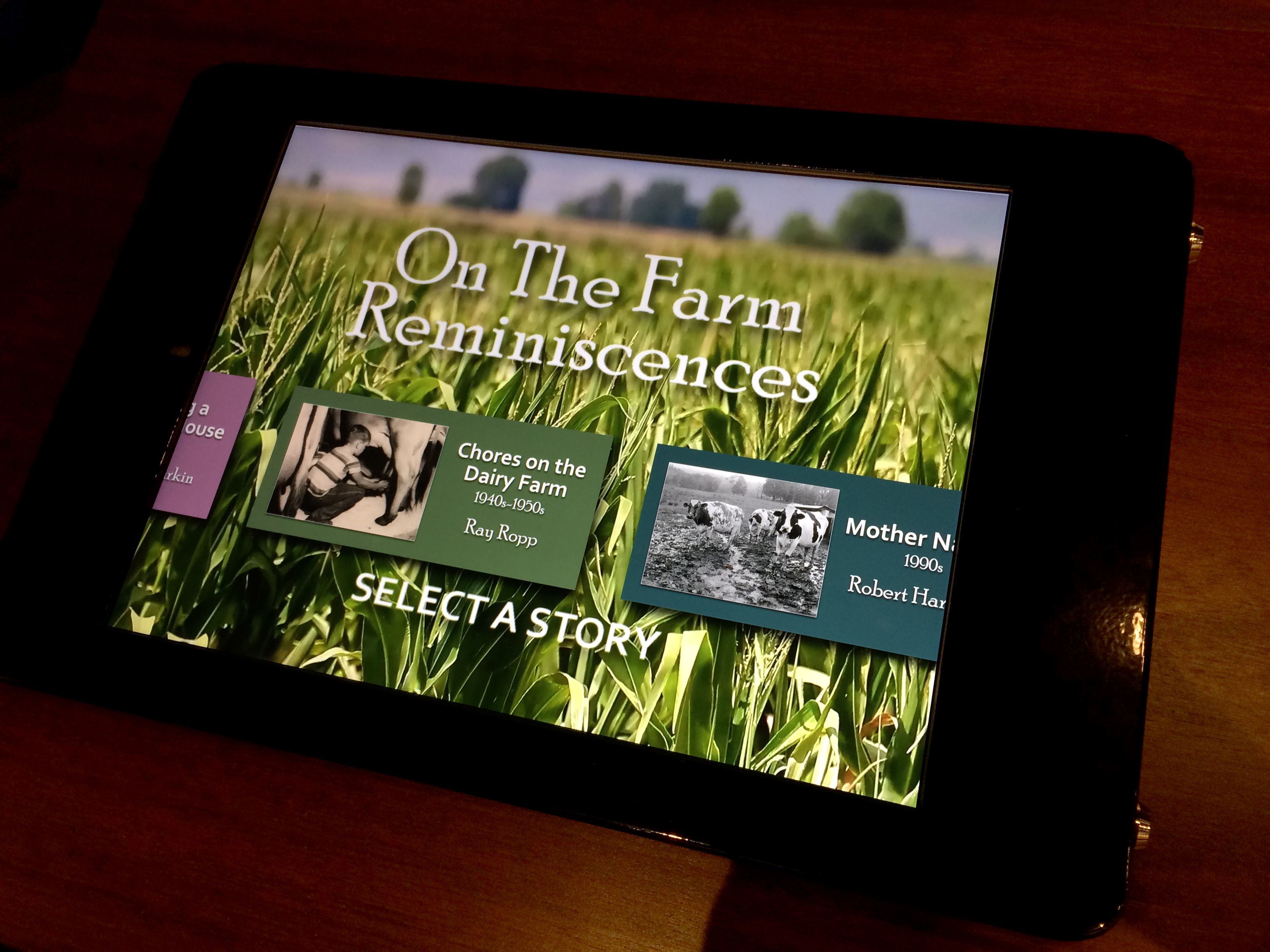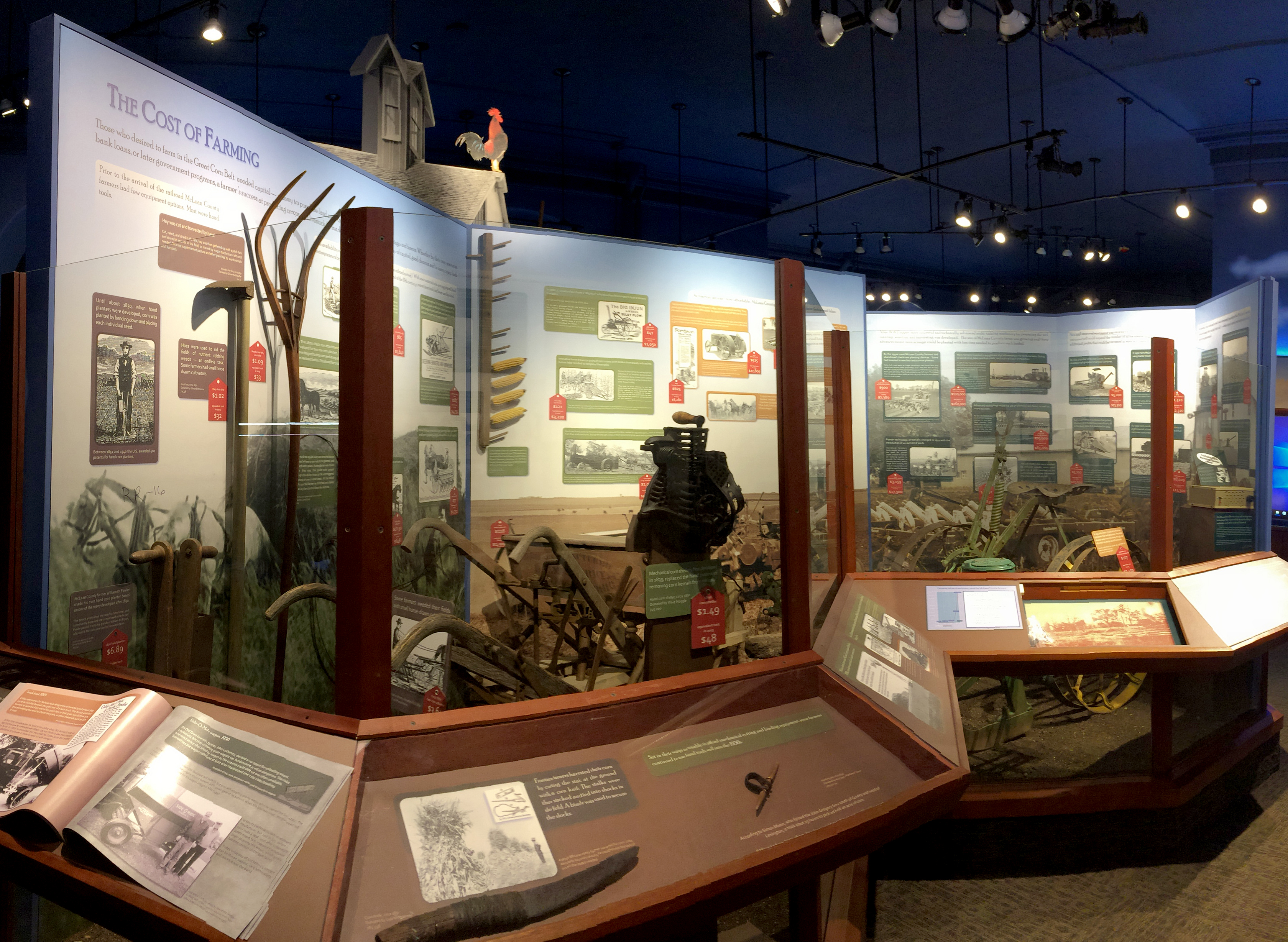The McLean County Museum of History’s newest permanent exhibit Challenges, Choices, & Change: Farming in the Great Corn Belt will open to the public on Saturday, March 25. Housed in the Franklin Family Gallery on the first floor, this new exhibit will feature local artifacts, images, video, digital interactives, and hands-on activities to connect visitors to McLean County’s rich agriculture history.
Festivities for the grand opening of Farming in the Great Corn Belt will begin at 10 a.m. with a ribbon cutting followed by an 11 a.m. program by Don Meyer, exhibit co-curator. There will also be a mini-Farmers’ Market with a selection of regular Downtown Bloomington Farmers’ Market vendors: PrairiErth Farm, Epiphany Farms, Ropp Jersey Cheese, Above Normal Eggs, Huelskoetter Pork, DBA, and Green Top Grocery. Family friendly activities will include butter making (featuring Kilgus Farmstead Creamery), a QR code scavenger hunt, fun with McLean County Ag in the Classroom Coordinator Bridget Caldwell, and more! These events are free and open to the public through 1 p.m. All exhibits will be open and free until 5 p.m. that day thanks to exhibit support from COUNTRY Financial, GROWMARK, and Illinois Farm Bureau.
Don Meyer and Museum Curator Susan Hartzold collaborated on this unique exhibit that tells the story of farming as it was done by McLean County farmers. Meyer is a veteran McLean County agricultural extension adviser and lecturer at Illinois State University’s Department of Agriculture.
“There was so much that we wanted to explore,” said Meyer. “Condensing nearly 200 years of farming into this one gallery was very challenging.”
Hartzold noted that a tremendous amount of time and research went into identifying images, experiences, and stories of farmers from across the area. “The result is that we are able to reveal the difficult choices local farmers made in order to be productive and profitable,” Hartzold explained.
New technology increases exhibit space
Space was a challenge for this exhibit. Farming is not only a big story to interpret, its associated objects, equipment, and structures are massive. Digital Humanities Curator Torii Moré helped Hartzold define how technology could be used to effectively show large equipment and explain sophisticated concepts within the gallery’s limited footprint. Farming in the Great Corn Belt incorporates a number of hands-on and digital interactives to engage and educate visitors.

“The digital interactives interspersed throughout the gallery do a good job of visualizing and demonstrating the drastic changes that farming has gone through since frontier farmers first arrived, including the size of farms, urban sprawl, technology and equipment, and even the types of crops grown,” Moré explained.
Challenges forced local farming innovations, change
Farming was the reason the first European came to and settled in McLean County in the early 1800s. They arrived after hundreds of years of farming by native people. Like those early residents, McLean County settlers faced constant change and numerous challenges. The Illinois prairie was rich when they arrived, but the earth was difficult to break and much of it was swampy. Farmers worked hard to get the most out of their land and to maintain it. Meyer points out early farmers also had to “work smart” using a wide variety of resources in order to insure that their work was productive and profitable.
The costs of land, equipment, buildings, livestock, and supplies were among the financial challenges they faced. After the railroad arrived in McLean County, so too did new equipment and an influx of immigrants. These newcomers provided a greater labor force, but also created competition for farmland.
Equipment advances meant a transition from the use of hand tools and horsepower to tractors. With the introduction of computer technology and larger equipment, prices skyrocketed. Natural forces also had a major impact on their successes and failures, as is true with today’s agriculture. As time passed, shifting markets and economic forces dramatically changed what McLean County farmers produced and where and how those commodities reached regional and world markets.

Regardless of the many generations that have passed, and the many challenges and difficulties they have faced, the McLean County farmers’ passion for their work is evidenced by their determination, resourcefulness, and innovation. The exhibit will explore innovations from draining fields and equipment to Funk Brothers hybrid seed and the conditions that led to today’s two-crop commodities of corn and soybeans. The exhibit will create an environment with sound and lighting that takes the visitor outdoors and it will include a small theater that is housed in a real grain bin.
The McLean County Museum of history is an Illinois nonprofit that annually serves more than 7,000 local students and 1,200 seniors in assisted-living facilities with free educational programs. The Museum is home to the Cruisin’ with Lincoln on 66 Visitors Center and is among the 3 percent of U.S. museums that is accredited by the American Alliance of Museums. To learn more, visit ww.mchistory.org.


